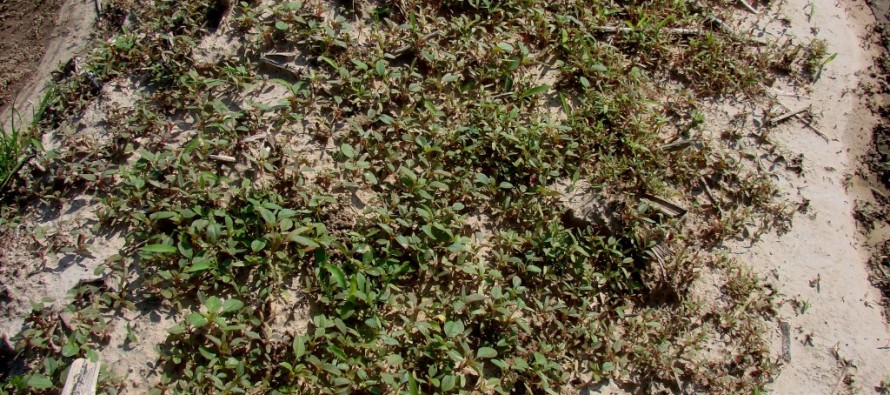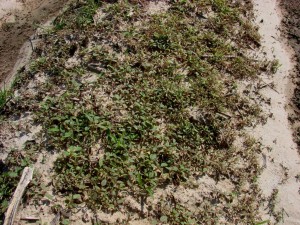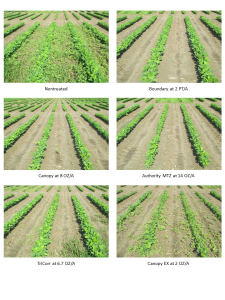Choices of Residual Herbicides in Mississippi Soybean

Most weed management decisions in Mississippi soybean are based on managing glyphosate-resistant (GR) Palmer amaranth. Because GR Palmer amaranth is an extremely aggressive weed species, its management should be addressed with multiple control tactics. One of these is designing herbicide programs that include multiple herbicide modes of action (MOA) effective on GR Palmer amaranth. Herbicides are grouped according to chemical family (triazines) and their MOA [acetolactate synthase (ALS) inhibitors]. Knowing a herbicide’s chemical family and MOA and which other herbicides have the same MOA are critical for designing an effective weed management program that considers herbicide efficacy and stewardship.
The prospect of tracking all the different herbicide MOAs can be overwhelming. However, a numbering system has been developed that makes it easier for growers and practitioners to diversify herbicide programs. Each herbicide MOA is assigned a standardized group number. This group number is printed on the first page of most herbicide labels, and it can also be found in a table that includes herbicide MOAs beginning on page 18 in the 2015 Weed Control Guidelines for Mississippi (MSU-ES Publication 1532). The numbering system makes knowing each MOA unnecessary. It also allows creation of herbicide programs that avoid combinations of sequential applications of the same herbicide MOA.
Recommendations for diverse herbicide programs targeting GR Palmer amaranth in soybean begin with residual PRE herbicides. Research has been conducted annually since 2010 in the Mississippi Delta to compare the efficacy of residual herbicides applied PRE in soybean. Treatments were applied within 48 hours of planting and included residual PRE herbicides currently recommended in Mississippi soybean as well as others recently introduced to the southern soybean market.
All treatments except Canopy EX controlled GR Palmer amaranth ≥92% 14 days after treatment (DAT). Authority MTZ and Prefix, which are mixtures containing multiple herbicide MOAs, controlled more GR Palmer amaranth 14 DAT than Canopy EX, Prowl H2O, TriCorr, and Valor SX. Prowl H2O, TriCorr, and Valor SX contain a single herbicide MOA.
Palmer amaranth control 28 DAT was ≥92% with Authority MTZ, Boundary, Canopy, Dual Magnum, Envive, Fierce, Gangster, Prefix, Valor SX, Valor XLT, and Zidua. In contrast to 28 DAT, Palmer amaranth control 35 DAT was greater following Envive, Fierce, Prefix, and Valor XLT compared with Canopy, Dual Magnum, and TriCorr. Prowl H2O and TriCorr or Canopy EX provided <80 or 70% control, respectively, 35 DAT.
Resistance to ALS inhibitors (Group 2) is prevalent in Palmer amaranth in Mississippi. Consequently, control with Canopy EX, which is a mixture of multiple ALS herbicides, was poor. Herbicide treatments that were mixtures containing protoporphyrinogen oxidase (PPO; Group 14) and/or very long chain fatty acid synthesis inhibitors (VLCFA; Group 15) were among the treatments that provided approximately 90% GR Palmer amaranth control as late as 35 DAT. Valor SX (PPO) and Zidua (VLCFA) each contain only a single active ingredient, but these herbicides provided control similar to mixtures containing PPO and/or VLCFA herbicides.
Several PRE herbicides provide early-season control of GR Palmer amaranth in Mississippi soybean. However, even at 14 DAT, no treatment provided complete control, so a POST herbicide would be required for complete control. In the event that a GR Palmer amaranth population evolves multiple resistance to PPO and/or VLCFA herbicides, control options will be severely limited with currently labeled PRE herbicides. Recommended herbicides for GR Palmer amaranth control can be found in the 2015 Weed Control Guidelines for Mississippi or in Herbicide Programs for Managing Glyphosate- and ALS-Resistant Palmer Amaranth in Mississippi Soybean (Information Sheet 1352).






Let me tell You a sad story ! There are no comments yet, but You can be first one to comment this article.
Write a comment